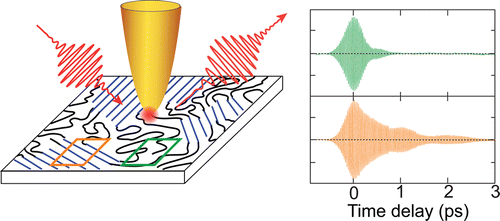Nanoscale probing of dynamics in local molecular environments
| Reviews and Highlights | Quantum Science | Molecular and Soft-matter | Ultrafast Nano-optics and Nanophotonics | Mineralogy and Geochemistry |
|---|
Joanna M. Atkin, Paul M. Sass, Paul E. Teichen, Joel D. Eaves, and Markus B. Raschke
J. Phys. Chem. Lett. 6, 4616 (2015).
DOI PDF

Vibrational spectroscopy can provide information about structure, coupling, and dynamics underlying the properties of complex molecular systems. While measurements of spectral line broadening can probe local chemical environments, the spatial averaging in conventional spectroscopies limits insight into underlying heterogeneity, in particular in disordered molecular solids. Here, using femtosecond infrared scattering scanning near-field optical microscopy (IR s-SNOM), we resolve in vibrational free-induction decay (FID) measurements a high degree of spatial heterogeneity in polytetrafluoroethylene (PTFE) as a dense molecular model system. In nanoscopic probe volumes as small as 103 vibrational oscillators, we approach the homogeneous response limit, with extended vibrational dephasing times of several picoseconds, that is, up to 10 times the inhomogeneous life time, and spatial average converging to the bulk ensemble response. We simulate the dynamics of relaxation with a finite set of local vibrational transitions subject to random modulations in frequency. The combined results suggest that the observed heterogeneity arises due to static and dynamic variations in the local molecular environment. This approach thus provides real-space and real-time visualization of the sub-ensemble dynamics that define the properties of many functional materials.
